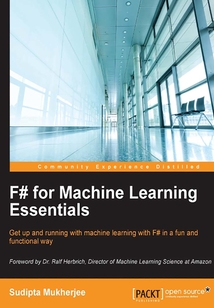目錄(81章)
倒序
- 封面
- 版權信息
- Credits
- Foreword
- About the Author
- Acknowledgments
- About the Reviewers
- www.PacktPub.com
- Preface
- Chapter 1. Introduction to Machine Learning
- Objective
- Why use F#?
- Unsupervised learning
- Machine learning frameworks
- Machine learning for fun and profit
- Recognizing handwritten digits – your "Hello World" ML program
- Summary
- Chapter 2. Linear Regression
- Objective
- Different types of linear regression algorithms
- APIs used
- The basics of matrices and vectors (a short and sweet refresher)
- QR decomposition of a matrix
- Linear regression method of least square
- Finding linear regression coefficients using F#
- Finding the linear regression coefficients using Math.NET
- Putting it together with Math.NET and FsPlot
- Multiple linear regression
- Multiple linear regression and variations using Math.NET
- Weighted linear regression
- Plotting the result of multiple linear regression
- Ridge regression
- Multivariate multiple linear regression
- Feature scaling
- Summary
- Chapter 3. Classification Techniques
- Objective
- Different classification algorithms you will learn
- Some interesting things you can do
- Understanding logistic regression
- Multiclass classification using logistic regression
- Multiclass classification using decision trees
- Predicting a traffic jam using a decision tree: a case study
- Challenge yourself!
- Summary
- Chapter 4. Information Retrieval
- Objective
- Different IR algorithms you will learn
- What interesting things can you do?
- Information retrieval using tf-idf
- Chapter 5. Collaborative Filtering
- Objective
- Different classification algorithms you will learn
- Vocabulary of collaborative filtering
- Baseline predictors
- Item-item collaborative filtering
- Top-N recommendations
- Evaluating recommendations
- Ranking accuracy metrics
- Working with real movie review data (Movie Lens)
- Summary
- Chapter 6. Sentiment Analysis
- Objective
- What you will learn
- A baseline algorithm for SA using SentiWordNet lexicons
- Handling negations
- Identifying praise or criticism with sentiment orientation
- Pointwise Mutual Information
- Using SO-PMI to find sentiment analysis
- Summary
- Chapter 7. Anomaly Detection
- Objective
- Detecting point anomalies using IQR (Interquartile Range)
- Detecting point anomalies using Grubb's test
- Grubb's test for multivariate data using Mahalanobis distance
- Chi-squared statistic to determine anomalies
- Detecting anomalies using density estimation
- Strategy to convert a collective anomaly to a point anomaly problem
- Dealing with categorical data in collective anomalies
- Summary
- Index 更新時間:2021-07-16 13:07:19
推薦閱讀
- 微服務設計(第2版)
- JavaScript+DHTML語法與范例詳解詞典
- Mastering phpMyAdmin 3.4 for Effective MySQL Management
- 青少年美育趣味課堂:XMind思維導圖制作
- HTML5 Mobile Development Cookbook
- Kotlin Standard Library Cookbook
- C語言程序設計實驗指導 (第2版)
- Java Web開發實例大全(基礎卷) (軟件工程師開發大系)
- 超簡單:用Python讓Excel飛起來(實戰150例)
- SFML Game Development
- ANSYS FLUENT 16.0超級學習手冊
- 透視C#核心技術:系統架構及移動端開發
- Visual FoxPro程序設計實驗教程
- 面向對象分析與設計(第3版)
- Python自動化運維:技術與最佳實踐
- The Python Apprentice
- C++ Primer(中文版)(第5版)
- HTML5+CSS3網頁布局項目化教程
- Python語言基礎
- ROS Robotics By Example
- Unity 2018 Cookbook(Third Edition)
- Learning IPython for Interactive Computing and Data Visualization
- Java Persistence with MyBatis 3
- 圖解交互設計UI設計師的必修課
- 系統辨識理論及Matlab仿真
- Netty進階之路:跟著案例學Netty
- PHP Web開發快速入門及實例精選
- JavaScript和jQuery實戰手冊(原書第2版)
- Data Analysis and Business Modeling with Excel 2013
- JavaScript前端開發案例教程


